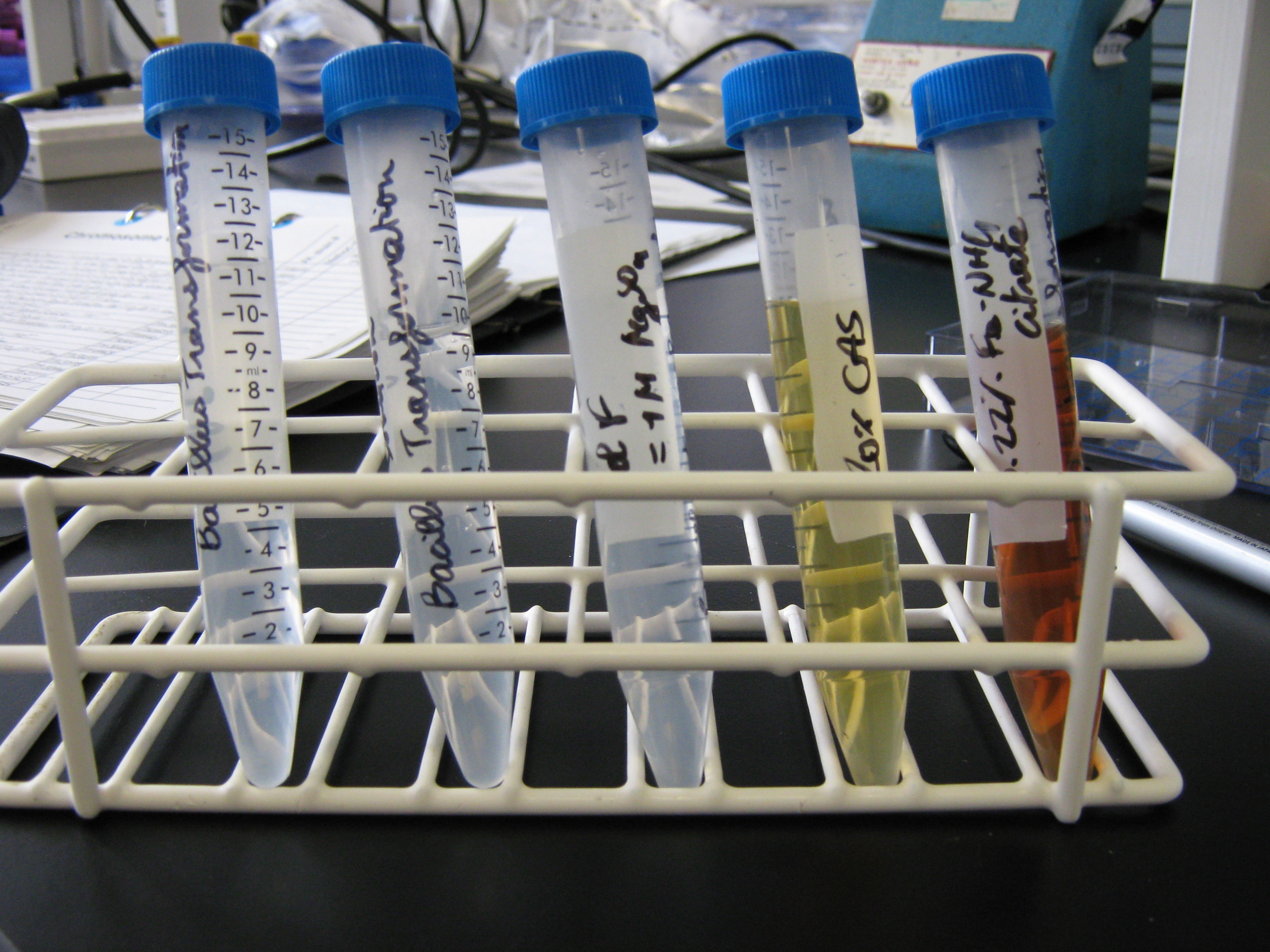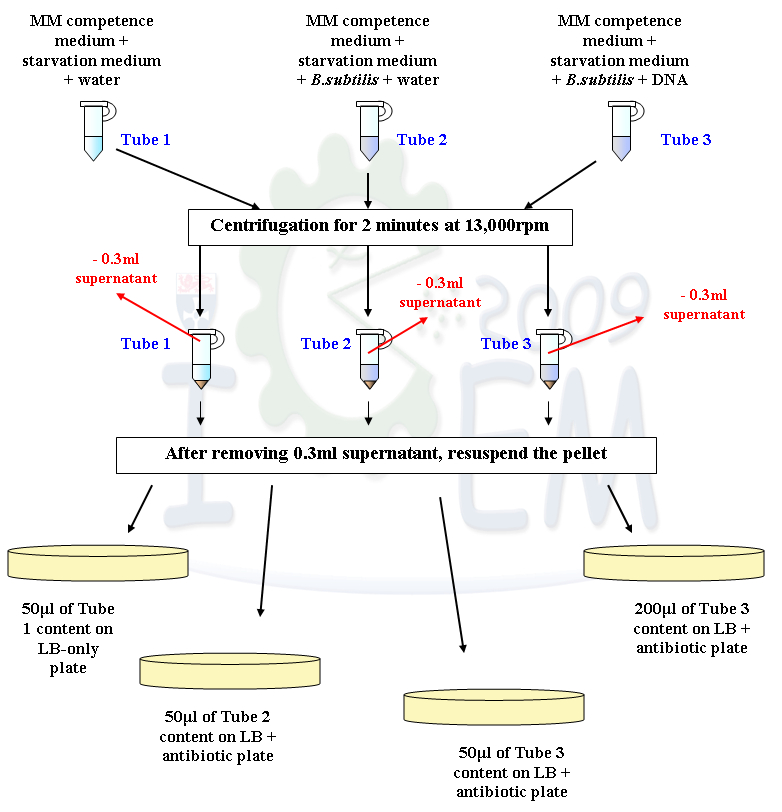Team:Newcastle/Project/Labwork/OurProtocols/TransformBac
From 2009.igem.org
Transforming into Bacillus subtilis 168
This protocol is designed to transform Bacillus subtilis 168 with a given BioBrick, which has been cloned into a suitable vector plasmid. This vector should be able to integrate with the Bacillus subtilis's genomic chromosome
Considerations
- If not already done so, make up the individual solutions involved in the MM competence medium and starvation medium prior to the day you intend to transform the Bacillus subtilis cells – this includes the SMM medium, solution E, tryptophane solution, solution F, 20% casamino acids and 0.22% Fe-NH4-citrate solution. It is recommended that you make up 10ml stocks of each of these solutions except for SMM, which should be made up to 1 litre.
- Don’t make up the MM competence medium or the starvation medium until the day you will be carrying out the transformations.
- To carry out this transformation you will need to produce an overnight culture of B.subtilis – therefore inoculate the growth media (LB) on the evening before the transformations making sure that you follow the rest of the protocol starting in the morning.
- This procedure will take over 6 hours to perform therefore make sure that you have your place in the lab booked for the whole day!
- Make sure that you know the resistance conferred by the plasmid you are trying to insert into B. subtilis – this is important in the final step when you will plate out the ‘transformed’ cells onto selective media.
What you will need
- 1 plate containing Bacillus subtilis 168
- DNA to be transformed (at least 10 microlitres)
- Loop – to inoculate growth media with Bacillus subtilis 168
- 5 test-tubes (for the individual solutions) – need to have capacity of 10ml
- 1 x litre flask for making up SMM medium
- 5 x 200ml bottles (to store the SMM medium)
- 2 x 50ml falcon tubes for the MM competence medium
- 1 x 50ml falcon tube for starvation medium
- 2 x 15ml falcon tubes (for overnight culture and overnight control)
- 2 x 50ml falcon tubes (for rest of procedure)
- 2 x Eppendorf tubes
Solutions needed
It is recommended that you make up 10ml stocks of each of the solutions and then aliquot them in 0.5ml amounts (in Eppendorf tubes) prior to transformations – the only exception is SMM medium which should be made up to at least 1 litre and should be stored in bottles. The aliquot method reduces contamination. The actual amount needed for the procedure is shown in bold.
SMM medium – this for 1 litre of solution:
- 2.0g of ammonium sulphate
- 14.0g of dipotassium hydrogen phosphate
- 6.0g of potassium dihydrogen phosphate
- 1.0g of sodium citrate dehydrate
- 0.2g of magnesium sulphate
- Distilled water – make up to 1 litre
MM competence medium:
- SMM medium - 10ml
- Solution E (40% glucose) – 0.125ml
- Tryptophane solution (at a concentration of 2mg/ml) – 0.1ml
- Solution F (1M MgSO4) – 0.06ml
- 20% Casamino acids – 0.01ml
- 0.22% Fe-NH4-citrate – 0.005ml
Starvation medium:
- SMM medium – 10ml
- Solution E (40% glucose) – 0.125ml
- Solution F (1M MgSO4) – 0.06ml
Procedure
Evening before transformations day
1) Make up 10ml of MM competence media using the recipe shown above – use aseptic technique where applicable.
2) Take 2 x falcon tubes (15ml) and, under aseptic conditions, add 10ml of MM competence media to each. Also using aseptic technique, remove some B. subtilis cells from the agar plate and inoculate one of the falcon tubes.
One tube will have Bacillus subtilis cells growing in it and the other will contain the just media with no B. subtilis cells. The latter will serve as a contamination control
3) Place both falcon tubes into shaking incubator (at 37ºC) and leave overnight.
On the day of Bacillus subtilis transformations (starting in the morning)
1) Make up the MM competence medium using the recipe seen in the ‘Solutions needed’ section.
2) Into two 50ml falcon tubes place 10ml of MM competence medium.
3) Pipette 0.6 ml of each of the 2 overnight growth media into the two tubes containing competence medium
4) Incubate these 2 tubes for 3 hours at 37ºC – in the meantime it might be worthwhile making up the starvation medium and keeping it incubated (this solution needs to be prewarmed when added later).
5) Once the 3 hours have elapsed, add 10 ml of prewarmed starvation medium to the two tubes and incubate at 37ºC for 1-2 hours.
6) Transfer 0.4ml of the competence solution (WITHOUT B. subtilis) into one Eppendorf tube and transfer 0.4ml of competence solution (WITH B. subtilis)twice into two Eppendorf tubes (so that each tube contains 0.4ml). To one tube containing Bacillus subtilis add 10µl of the DNA. To the other two tubes (one containing B. subtilis and the other containing just competence solution with no B. subtilis) add 5-10µl of water. Place these in the shaking incubator for 1 hour at 37ºC.
To find out how to carry out the incubation step successfully, see the ‘Important Notes’ section below.
7) Transfer the three Eppendorf tubes to the centrifuge and spin for 2 minutes at 13,000 rpm.
8) Subtract 0.3ml of supernatant from the Eppendorf tubes – you may need to re-centrifuge the tubes if pellet has resuspended.
9) Resuspend the pellet in the remaining supernatant using a pipette and then plate on agar plates with the appropriate antibiotic.
Important Notes
When carrying out the incubation at step 6 it is important that the tubes are placed on their sides so that the medium is allowed to aerate. As Eppendorf tubes will be used, the easiest way to ensure aeration is to seal the tubes and tape them down (on their sides) to the base of the shaking incubator. Make sure they are securely fastened to the bottom of the incubator.
News
Events
- 20 – 21 June 2009 - Europe workshop (London)
- 23 – 24 June 2009 - UK iGEM meetup (Edinburgh)
- 23 October Practice Presentation (Newcastle)
- 23 October T-shirts are ready
- 27 October Practice Presentation (Sunderland)
- 27 October Poster is ready
- 30 October – 2 November 2009 - Jamboree (Boston)
Social Net
- Newcastle iGEM Twitter
- [http://www.facebook.com/home.php#/group.php?gid=131709337641 Newcastle on Facebook]
- [http://www.youtube.com/user/newcastle2009igem Newcastle Youtube Channel]
 "
"




